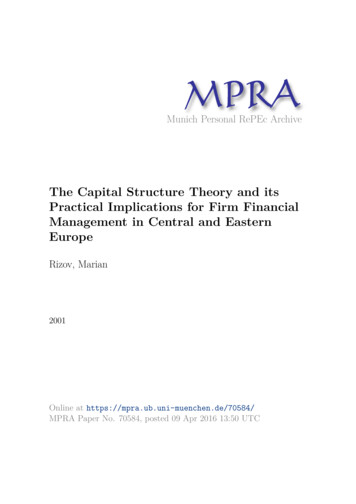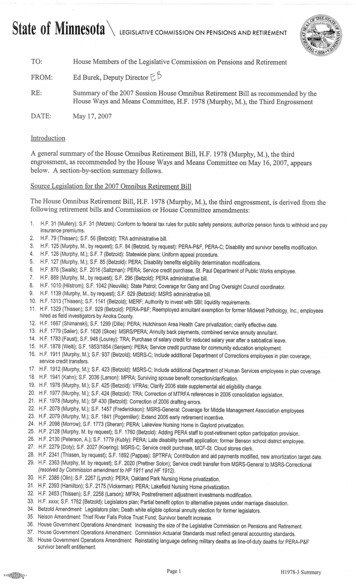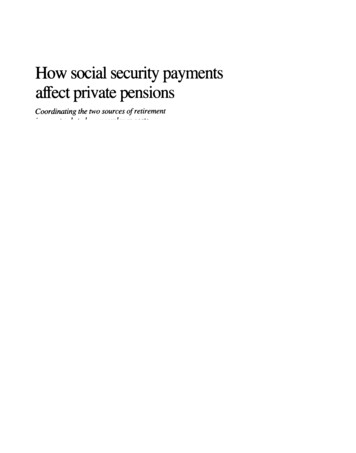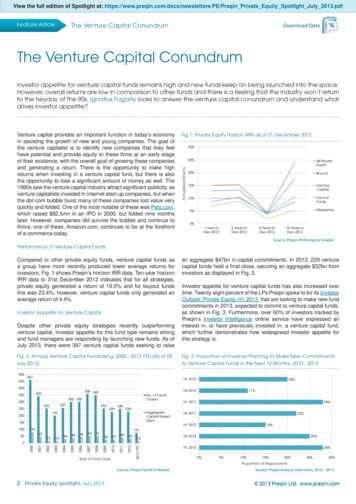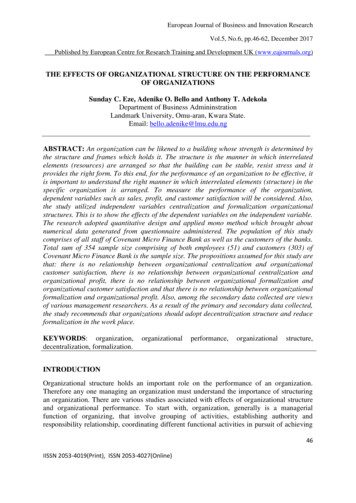
Transcription
Pensions and Capital Structure: Why HoldEquities in the Pension Fund?John RalfeCliff SpeedJon PalinPresented at The Great Controversy: Current Pension Actuarial Practice inLight of Financial Economics SymposiumSponsored by the Society of ActuariesVancouverJune 2003Copyright 2004 by the Society of Actuaries.All rights reserved by the Society of Actuaries. Permission is granted to make briefexcerpts for a published review. Permission is also granted to make limited numbersof copies of items in this monograph for personal, internal, classroom or otherinstructional use, on condition that the foregoing copyright notice is used so as togive reasonable notice of the Society’s copyright. This consent for free limitedcopying without prior consent of the Society does not extend to making copies forgeneral distribution, for advertising or promotional purposes, for inclusion in newcollective works or for resale.(note: The quotations appearing in this monograph are exact, except where capitalization andpunctuation were changed in keeping with modern style and grammar guidelines.)1
AbstractThis paper considers the pension plan as part of the capitalstructure of the sponsoring employer. This enables lessons fromfinancial theory concerning capital structure to be used to answerthe question "what assets should a pension fund hold?”. Thestandard Modigliani-Miller framework is expanded on to considerthe implications of corporate tax. This leads to the conclusion thatbond investment for pension plans has tangible advantages overholding risky assets (e.g. equities). The paper considers a case studyof the pension plan of The Boots Company, a UK pharmacy retailerwith a pension fund of around 2.3bn ( 3.5bn), where these ideaswere put into practice. Finally the paper discusses the valuereleased to shareholders and the extra security members of thepension fund have derived from putting theory into practice.1. IntroductionFor the last 40 years US and UK pension funds have invested themajority of their assets in equities: the average equity allocation for a UKpension fund in 2002 was 73% (Source Hewitt Bacon & WoodrowPensions Pocket Book 2003). However in November 2001 The BootsCompany final salary plan, with 2.3 billion of assets turned its back onequities. The Boots plan announced it had sold all of its equities andshort term bonds in the 15 months to July 2001 and was 100% invested inlong-dated AAA sterling fixed and inflation linked bonds.Why do pension plans hold the majority of assets in equities? Twojustifications are usually offered. Equities are considered to match salary related liabilities and thusallow pension assets to grow in line with pension liabilities.Statistical analysis has demonstrated that this relationship does nothold in the UK, as pointed out by Smith (1998). This was confirmedby the UK actuarial profession when asked by the AccountingStandards Board (ASB) to consider what discount rate should be usedfor discounting pension liabilities for the Financial ReportingStandard 17 (FRS17).2
Equities outperform bonds in the long run. Equities are riskier thanbonds, since they have lower priority over a company’s operatingassets. Because of the higher risk it is a truism to say that equities areexpected to outperform bonds. This out-performance has been borneout historically, over long periods, especially in the US and UK,which have the longest uninterrupted series of data. (Though not ofcourse in Japan, the second largest world economy.) The truism thatequities are expected to outperform bonds in the long run supportsthe proposition that the longer the time horizon, the more likely thatequities will outperform bonds. This is then often mis-interpreted as“the risk of holding equities versus bonds decreases the longer thetime horizon”. The “long term” nature of pension funds, comparedwith other investors, seems to clinch the argument for pension fundsholding equities. Pension funds can apparently be rewarded versusother investors for their ability to take a long term view. Thisargument is fatally flawed; there is not a free lunch for those with along time horizon. The risk of an equity portfolio increases over time.This is well demonstrated by considering an option to protect againstequity downside whose cost increases with term. (see Bodie 1995).The economist Paul Samuelson went further describing it as a“blunder if not a crime” for a fiduciary trustee to believe thatequities’ risk decreases over time.Equity investment for pension funds looked to have served pensionfunds well throughout the 1980s and 1990s as they accumulatedincreasing surpluses thanks to bull markets. In recent years this bias toequities has often been supported by actuarial asset-liability studies.These studies show a range of possible outcomes for different measures(e.g. funding level, contribution rate etc) at different projection horizons.Based on the probabilities of these measures trustees are asked to makeasset allocation decisions.In this paper we show the fallacy of the plan centred approach byconsidering the wider implications of the asset allocation to equities. Ascan be seen from the Modigliani-Miller (1958) (MM) frameworkchanging asset allocation does not create value. Further, the impact oftax needs to be considered. We follow the approach adopted by Black(1980) and consider the impact different asset allocations have on theultimate investors in the sponsoring company. We show that byinvesting in equities the pension plan is not doing anything theshareholder cannot do directly and in a more tax efficient way.3
The move by Boots has shown how theory can be put into practice.We consider what this decision has meant and discuss the benefits thathave arisen from this move.The paper is set out as follows: in section 2 we consider pensionliabilities; in section 3 we consider pensions in the MM framework; insection 4 we introduce taxation and quantify the possible gain toshareholders; in section 5 we consider the particular case of Boots;section 6 concludes.2. Pensions and capital structureWhat are pension liabilities?A defined benefit (DB) pension is a promise made to an individual topay an income of a pre-defined amount during retirement. DB pensionpromises issued as part of the overall employee remuneration packageare part of deferred pay. The pension is an asset for the individual andwill provide a retirement income.Although different funding and regulatory systems exist around theworld, the economics of DB plans are the same. Pension promisesrepresent a debt owed by the company to the pension plan members.Pension liabilities are economic liabilities of the company, not thepension plan, as the company has to make good shortfalls in the pensionplan1. The pension represents a debt owed by the company to thepension fund members.Although U.K. and U.S. regulation requires separate assets assecurity for pension promises, this is not a necessary feature - indeedmost DB plans in continental Europe are unfunded. The ultimateowners of the company are the shareholders who own the net value afterliabilities of the company are met. In simple terms we have an economiccontract between the shareholders and the pension plan members.Although pensions are debt, pension debt is more complex than aconventional bond,1In some cases the company may be insolvent and so avoids making good the shortfall, in additionthere is the possibility that legislation may allow the company to cease contributing to the plan and notbe held liable for the pensions accrued to date.4
the number of payments to be made depends on mortality rates,withdrawal rates and other demographic features. UK pensions often increase in payment (and deferral) and theseincreases are based on indices, most commonly the rate of inflation. pension promises are not readily traded.These complexities do not alter the underlying economics thatpension promises are debt-like for the sponsor.The view that pensions are debt-like is gaining ground in theinvestment community. Investment banks have publishing numerousarticles which recognise pensions as debt-like and credit rating agenciesare treating unfunded pensions as debt in their analysis.Since pensions are the equivalent of debt why do pension funds holdthe majority of their assets in equities? Surely this is equivalent to thecompany issuing a long-term bond and investing the proceeds inequities. This gearing on balance sheets to gain equity market exposureis not seen outside of investment trusts. So why should we see this inpension funds? (Following an article in the Financial Times it hasbecome a joke in the UK that British Airways, which has a marketcapitalisation of 1.4bn and pension liabilities of over 10bn, is a badlyrun hedge fund that happens to own a few aircraft).We now consider in some detail why there is no gain from issuingdebt to invest in equities. As we run through these arguments we cankeep in mind pension funds and ask whether special circumstances existwhy the analysis would not apply to them.3. Modigliani-Miller framework (and pensions)Modigliani-Miller’s (MM) first proposition (1958) says that the“market value of a firm is independent of its capital structure” - in otherwords there is no gain from altering the debt/equity ratio of a firm. Thefirm generates earnings and cash flows and the capital structuredetermines how these are split between the shareholders and thedebtholders. However changing the proportions of debt and equity willnot alter the actual earnings and cash flows of the firm, but merely altertheir distribution. Equities will become more risky as the companyissues more debt and gears up its balance sheet but the combined value,or “enterprise value”, of the company does not change. This result hasprofound implications. In particular it enables us to separate the5
financing decisions (where the money comes from) and investmentdecisions (where a company invests its money) that a firm has to make.Holding equities in the pension fund is the same as gearing upissuing debt in the company. In a pension context proposition one tellsus that the asset allocation decision to hold equities or bonds does notalter the value of the company.The MM proposition is true in an idealised world where there are nomarket imperfections e.g. no taxes, no transaction costs, no agency costsand everyone can lend and borrow at the risk free rate. MMdemonstrated that financing decisions do not affect the value of a firm inthis idealised world and that it is the so-called second order effects suchas taxation, agency costs and transaction costs which are the real driversof value. It is these second order effects that have been the focus ofresearch. This research has extended the MM framework into a bettermodel of the real world.One of the key insights of MM was to recognise that a company cannot be looked at in isolation. Investors in a particular company have thefull universe of investments available to them, therefore the risk andreturn trade-offs available elsewhere in the market are relevant whenconsidering what represents fair compensation to investors in aparticular company. Consider a simplistic example of a company set outbelow in Figure 1. The company makes investments in different projectsthat have positive net present value (NPV). This is where the value ofthe company derives from (see Figure 1).Figure 1Investment decision: what projectswill a company nancing decision: where the capitalcame from and how the proceeds aresharedMM proposition two says that the expected rate of return increaseswith the riskiness of the debt. So as a company issues more debt the6
expected return to shareholders increases, but this is just faircompensation for the risk. Following the approach used in “A Primer inFinancial Economics” (2002) we consider two companies ‘NoDebtCo’which is totally financed by equity and ‘HalfDebtCo’ which is 50%financed by debt and 50% financed by equity. These companies areidentical apart from their financing. For both companies the total valueof their assets is 100, the return earned on assets is 15% giving them thesame profit and the interest rate payable is 5%. So NoDebtCo has Equityoutstanding with a value of 100 and no debt, and HalfDebtCo has equityoutstanding with a value of 50 and debt outstanding with a value of 50.Table 1 shows the profit and loss accounts.Table 1Scenario 1Operating ProfitInterestProfit after interestReturn to 5%By construction the operating profit earned is not affected by thecapital structure of the two companies. However the return toshareholders is either 15% or 25%. Although in this case HalfDebtCoprovides a higher return to shareholders it is a more risky investment;this can be seen in the situation where operating profit falls to 0 inscenario 2. Then the returns are as given in Table 2.Table 2Scenario 2Operating ProfitInterestProfit after interestReturn to Is the higher return for shareholders is HalfDebtCo a faircompensation for the added risk of investing in HalfDebtCo?Let’s consider an investor who has an equity holding in NoDebtCowith a value of 5. This investor wants a higher return than NoDebtCo’sequity is expected to provide and is willing to take additional risks to7
secure this return. One possibility is for the investor to sell their holdingin NoDebtCo and invest in HalfDebtCo.Alternatively the investor could borrow money to buy an additionalholding in NoDebtCo. Let’s assume that the investor borrows 5 andinvests this in NoDebtCo. At time 0 the investor’s balance sheet isCashNoDebtCo EquityNet assets(5)105borrowingIf NoDebtCo returns 15% as in scenario 1 then the investor’s personalbalance sheet at the end of the period will look likeCashNoDebtCo EquityNet assets(5.25)11.56.25borrowing with interestThis gives a return on assets of 25% which is precisely the return thatthe investor would have received from investing in HalfDebtCo over theperiod. Similarly in scenario 2 where equity in NoDebtCo returns 0%the investor’s strategy of borrowing to invest in NoDebtCo delivers areturn of -5%, the same as an investment in HalfDebtCo. This of courseis no coincidence and provides insight into how MM derived theirresults using no arbitrage arguments and assuming that investors can allborrow and lend at the same risk free rate.MM’s results rest on the now familiar arbitrage approach ofrecognising that if two assets have the same payoffs in all situations theymust have the same price. Note that expected returns are not relevant tothis argument. We are not making a probabilistic statement. Theassessment of the risk and return is left to the market where prices arethe mechanism that reflects investors views of the potential rewardsrequired to accept further risk. In short 100 of equities is of equal valueto 100 of bonds. From this simple statement it follows that value cannot be generated by switching between bonds and equities in the MMworld.We have now seen a simple example that demonstrates that valuecan not be created by altering the capital structure as this can bereplicated by an individual rearranging their investment portfolio. Wehave also seen that the extra return from gearing up a firm’s balancesheet provides higher expected returns to shareholders but this is fair8
compensation for the risks they face. Now let’s extend our example tocover the case of a company that is preparing to expand. Initially thecapital structure is as shown is Figure 2a).Figure 2a)Figure 2b)ProjectsProjectsNew sShareholdersNewVentureCoDebtholdersNew DebtholdersSuppose the company goes ahead and raises the finance for the newinvestment opportunity. The intention is that this capital will beinvested in new projects that will provide a flow of profits to the parentcompany and ultimately the shareholders as shown in Figure 2b).However before the new investment can get underway there are someregulatory hurdles to clear. The company decides to protect the capital ithas raised by investing in debt until the regulatory hurdles are cleared.The interest on this debt will enable the company to meet the interestpayments to the new debtholders and not touch the capital raised. Froman economic viewpoint the debt held is an asset and the debt owed to thenew debtholders is a liability. These exactly cancel out and so thepicture is exactly the same as before the debt was raised. The situationthen looks like Figure 3Figure VentureCoNew Debtholders9
However, the regulatory hurdles take longer than expected to becleared and the prospect of actually starting the venture recedes. All thewhile the new money is invested in debt. Eventually it is suggested thatif the capital raised was invested in equity then it would deliver anexpected return in excess of that required to meet interest payments.The situation would now look like Figure 4.Figure 4ProjectsCompanyShareholdersEquityExpected equityoutperformanceDebtholdersNewVentureCoNew DebtholdersWith the benefit of the MM framework we realise that the value ofthe company is not changed by moving the investment from debt toequity. All that happens is that the gearing of the company increasesand the equity holders require a higher return to compensate for the riskthey now hold.Of course our ‘NewVentureCo’ is no such thing; it is just a DBpension plan.The whole MM analysis translates directly into thepensions environment.4. The Impact of Corporate TaxUnfortunately the real world has many additional complications, notleast of which is tax. We now introduce corporate tax into our modeland consider the impact on simple profit and loss accounts (P&L) andbalance sheets. As we are interested in the economic exposure of theultimate investors we will show pension gains and losses on the P&L.10
For ease of exposition we will consider a fixed interest rate andignore the effects of personal taxation (although we will comment onpersonal taxes later). These do not change the structure of the argument.Let’s start by setting up some simple notationD the debt issued by the companyE the equity of the companyProfit the operating profit of the company in the yeari the interest ratereq return on the equity market over the yeartax the corporate tax rateBold text indicates an item which is unknown at the start of the year.We will also consider the pension plan. For simplicity we will assumethat only two asset classes are available to the pension plan - equities andbonds. We use the notation :L the pension liabilitiesS the solvency ratio of the pension plan (a percentage)Aeq the percentage of the pension plan assets invested in equities(for example the FTSE100 index)Now we can now set out our sample P&L statement as shown intable 3.Table 3(1)(2)(3)(4)(5)(6)Operating ProfitPension fund gainDebt interestPre-tax Profit (1) (2) – (3)Corporate Tax (4) x taxPost-Tax Profit (4) –(5)Profit and Loss StatementProfitL.(S.Aeq.req S.(1-Aeq)i– i)i.DProfit L.(S.Aeq.req S.(1-Aeq)i– i)–i.Dtax.(Profit L.(S.Aeq.req S.(1-Aeq)i– i)–i.D)(1-tax).(Profit L.(S.Aeq.req S.(1-Aeq)i– i)–i.D)We can now contrast two companies that are identical in everyrespect apart from their pension plan investment strategy. The first,‘EquityPensionCo’ invests its pension plan assets in equities (Aeq 100%)and the second ‘BondPensionCo’ invests its pension plan assets in bonds(Aeq 0%). We will assume that both pension plans are 100% solvent atthe start of the year (S 100%).11
Table 4Post-Tax ProfitEquityPensionCo(1-tax).(Profit L(req– i) –i.D)BondPensionCo(1-tax).(Profit –i.D)This shows us that the impact of investing the pension plan inequ
pension fund have derived from putting theory into practice. 1. Introduction For the last 40 years US and UK pension funds have invested the majority of their assets in equities: the average equity allocation for a UK pension fund in 2002 was 73% (Source Hewitt Bacon & Woodrow Pensions Pocket Book 2003). However in November 2001 The Boots


